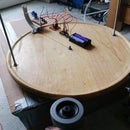Introduction: Experimental Determination of the Planckian Radiation Curve - Why Have Stars Different Colours
Why have stars different colors? Some appear reddish, our sun yellowish-white and others bluish? The reason lies in the so-called Planckian radiation curve.
Max Planck (1858 - 1947) was one of the most important physicists of all time and received the Nobel Prize in Physics in 1919 for his work.
The Planckian radiation curve describes the light intensity emitted by a black body as a function of the wavelength. A blackbody with a certain temperature T has a characteristic spectrum of light that he emits. This depends exclusively on its temperature T. The higher the temperature, the greater the overall radiation intensity emitted (= energy per second and m²). So the curve gets higher as T increases. The so-called Stefan-Boltzmann law states that a doubling of the temperature T causes a 16-fold increase in the total radiation intensity (area under the curve).
In addition, the maximum of the radiation curve shifts towards shorter wavelengths with increasing temperature. Wien's displacement law states that the product of the wavelength of the radiation maximum lambda_max and the temperature T is constant. An increase in temperature therefore causes a lower lambda_max. In other words, the curve maximum shifts to the blue wavelength range.
A red star with a greater lambda_max has a lower surface temperature than a yellow or blue one. The surface temperature of our sun is about 6000 °C. Therefore, the maximum of Planck's radiation curve is in the green spectral range and our sun appears whitish-yellow. If the star's temperature increases further, lambda_max shifts towards blue and the star appears bluish.
Supplies
For the experimental determination of Planck's radiation curve you need a spectroscope consisting of a diffraction grating or a prism, a light source (= black body radiator, in my case an ordinary halogen lamp) and a light detector consisting of a photodiode. Since most of the light emitted by a halogen lamp is in the infrared spectral range, the photodiode must be sensitive in the IR range. For this reason I use an InGaAs photodiode. This can detect wavelengths between 800 nm and 1700 nm. The light intensity is converted into a voltage by a so-called transimpedance amplifier (TIA). This can then be easily measured with a voltmeter.
A 12V halogen lamp is used as a black radiator. In order for this to have different temperatures, it must be controlled with a variable voltage of 0-12V. For this I made a small power supply consisting of a 14V notebook power supply and a buck converter.
I would like to record the Planckian radiation curves at different temperatures. To do this, I need to know the temperature of the halogen lamp. This is done by determining their electrical resistance. This increases with increasing temperature. If I know the resistance R_0 of the halogen lamp at room temperature and then the resistance R at a specific voltage U, I can use a simple formula to determine the temperature T.
To determine the resistance of the halogen lamp easily, I installed an ammeter and voltmeter in the power supply. The respective resistance R of the halogen lamp is then obtained simply using Ohm's law as R = U / I.
Example: R_0 = 0.36 ohms, U = 9V, I = 2 A: R = U/I = 9/2 = 4.5 ohms
T(4.5 ohms) = 20 + (-4.11 * 10^-3 + SQRT((4.11 * 10^-3)² + 4 * 9.62 * 10^-7 *((4.5 / 0.36) - 1))) / (2 * 9.62 * 10^-7)
T(4.5 ohms) = 20 + 1928 = 1948 °C
Step 1: The Spectroscopes
For the spectroscope you need something that splits the light into its individual wavelengths. A prism or a diffraction grating is suitable for this purpose, for example. I implemented both here.
The halogen lamp is located in front of a thin slit in both spectroscopes. I create this using two razor blades. In the case of the prism spectroscope, there is a lens behind the slit, the so-called collimator. This directs the light that penetrates the slit parallel again.
This parallel light then passes through the prism, where it is broken down into its spectral components. Another lens is located behind the prism, the so-called imaging lens. This ensures a sharp spectrum at the location of the light detector.
The photodiode is located on a slide gauge so that the position of the photodiode can be changed in a reproducible manner. So I always know exactly the light intensity depending on the location or the wavelength.
The grating spectroscope has an imaging lens after the slit. Behind it comes the diffraction grating and the photodiode on the caliper.
With the prism spectroscope, it is important to use a prism that splits the individual colors of the light particularly well. This is the case with flint glass. Normal crown glass is less suitable because the spectrum is less fanned out, i.e. broad.
For the grating spectroscope, I use a diffraction grating with 100 lines/mm. You can get this cheap on ebay or aliexpress.
Step 2: The Results
The experiment now consists of moving the photodiode step by step on the caliper and recording the respective voltage of the light detector as a function of the position. In this way one obtains the Planckian radiation curve. This is repeated for different voltages of the halogen lamp, i.e. for different temperatures of the blackbody.
As you can see from my results, the curves grow very strongly with increasing temperature T (= Stefan-Boltzmann law). In addition, one can see that the maximum of the radiation curves shifts to the left in the direction of shorter wavelengths with increasing temperature (= Wien's law of displacement).
With the grating spectroscope one can very easily convert from the respective position x to the wavelength lambda with a simple diffraction formula. This is more difficult with the prism spectroscope. To do this, the prism spectroscope would first have to be calibrated with different lasers. Therefore, only the position x is on the x-axis of the prism spectroscope, while the wavelength is given for the grating spectroscope.
Step 3: The Simulation With Excel
You can also create the well-known Planckian radiation curve with Excel. The respective temperature T is set with a slider and observed how the Planckian radiation curve changes. You can also add up (integrate) the area below the curve, which then corresponds to the total emitted light intensity. According to the Stefan-Boltzmann law, this should then change very strongly with temperature.
The Excel program can be found on my homepage: link
Step 4: Conclusion
So now we know how to determine the Planckian radiation curves experimentally and why a body with a certain temperature has a certain color. In the case of our sun, with its surface temperature of 6000 °C, the maximum of the Planckian radiation curve at around 550 nm is exactly in the for our eyes visible spectral range. During evolution, our eyes have adjusted to this fact.
If you are interested in other exciting physics projects, here is my Youtube channel and my homepage:
On that note, stay curious and Eureka!






